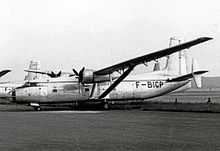Hurel-Dubois HD.31
| HD.31, HD.32, and HD.34 | |
|---|---|
 | |
| The prototype HD.31 demonstrating at Coventry Airport in June 1954 | |
| Role | Airliner |
| National origin | France |
| Manufacturer | Hurel-Dubois |
| First flight | 27 January 1953 (HD.31) 29 December 1953 (HD.32) |
| Primary user | Institut Géographique National |
| Number built | 11 |
|
| |
The Hurel-Dubois HD.31, HD.32, and HD.34 were a family of civil aircraft produced in France in the 1950s, based on Maurice Hurel's high aspect ratio wing designs.
Design and construction
Tests with the Hurel-Dubois HD.10 research aircraft had validated Hurel's ideas about the practicality of such wings, and the French government agreed to sponsor the construction of two prototypes of a medium-range airliner utilising this same principle. These aircraft, the HD.31 and HD.32 were conventional designs in all respects other than their unorthodox wings, and differed from one another only in their powerplants, although both were later converted to use the same engines. The twin-tails originally fitted were also later replaced by a large single tail fin assisted by smaller auxiliary fins. With their new engines and tails, they were redesignated HD.321.01 and HD.321.02. Apart from the HD.34 survey aircraft, all had fixed, faired tricycle undercarriages.
Production and Operation

Two HD.31s were ordered by the French government but only one was built, the Wright Cyclone-powered HD.31 F-WFKU flew on the 27 January 1953. The company then produced a Pratt & Whitney R-1830-92-powered variant, the HD.32. Other than the engines it was the same as the HD.31. Keeping the original twin tails of the prototype the first HD.32 flew on 29 December 1953. The engines were changed to 1525hp Wright 982-4 engines and to counter the increased power the twin fin was replaced by a single one and the type was redesigated the HD.321. The second HD.32 which first flew in February 1955 was also modified to HD.321 standard.
Air France originally placed an order for 24 aircraft in November 1953 to use as feederliners, it was followed by an order for four for the Institut Géographique National and four for Aigle Azur. With these orders discussion took place with SNCASE to build and market up to 150 aircraft. None were actually built for Air France or Aigle Azer but the IGN continued to be interested in an aerial photography variant to replace the Boeing B-17 Flying Fortress the company was then using. Eight aircraft were ordered by the IGN, based at Creil airfield to the north of Paris. The aircraft's wing design made it ideal for long-duration, low-speed flight, ideal for aerial photography and survey work. These machines were designated HD.34 and were fitted with an extensively glazed nose and an offset retractable nosewheel. They flew with IGN between the late 1950s and mid 1970s. A single example remains airworthy, operated by the Association des Mécaniciens-Pilotes d'Aéronefs Anciens.
The Aeronatique Naval evaluated the HD.31 and the company proposed an anti-submarine warfare variant to meet a requirement for 100 aircraft but nothing materialised.
Variants

- HD.31 - prototype with Wright Cyclone C7BA1 radial engines (one built)[2]
- HD.32 - prototype with Pratt & Whitney R-1830 radial engines. (two built)
- HD.321 - prototype with Wright Cyclone 982 engines and single fin. (two converted from HD.32 by replacing twin fins with a single central and two small auxiliary fins)
- HD.324 - turboprop version with Rolls-Royce Dart engines. (not built)
- HD.33
- HD.331 - projected militarised version for use as troop transport or air ambulance. (not built)
- HD.34 - aerial survey version for IGN. (eight built) Retractable, offset nosewheel.
- HD.35 - a proposed anti-submarine variant for the French Navy, not built.
- HD.37 - a proposed car-ferry version, not built.
Operators
- French Air Force - one HD.321
- French government - one HD.321
- French Naval Aviation - the HD.31 was used for evaluation
- Institut Geographique National - eight HD.34s
Specifications (HD.34)
General characteristics
- Crew: Five
- Length: 23.57 m (77 ft 4 in)
- Wingspan: 45.30 m (148 ft 7 in)
- Wing area: 100.0 m2 (1,076 ft2)
- Empty weight: 12,300 kg (27,060 lb)
- Gross weight: 18,600 kg (40,920 lb)
- Powerplant: 2 × Wright Cyclone 982-C9-HE2, 1,140 kW (1,525 hp) each
Performance
- Maximum speed: 280 km/h (175 mph)
- Range: 2,200 km (1,375 miles)
- Service ceiling: 8,000 m (26,200 ft)
References
- Notes
- ↑ http://1000aircraftphotos.com/Contributions/Visschedijk/8394.htm
- ↑ "French Air Oddities." Popular Mechanics, December 1953, p. 115.
- Bibliography
- Taylor, Michael J. H. (1989). Jane's Encyclopedia of Aviation. London: Studio Editions. pp. 523–24. ISBN 0-7106-0710-5.
- World Aircraft Information Files. London: Bright Star Publishing. pp. File 896 Sheet 30. ISBN 1-156-94382-5.
- Simpson, R. W. (1995). Airlife's General Aviation. Shrewsbury: Airlife Publishing. p. 424. ISBN 1-85310-577-5.
- "Hurel-Dubois Transports". Flight: 676. 28 November 1952. Retrieved 2008-05-04.
- "Flying in the Hurel-Dubois". Flight: 180. 7 August 1953. Retrieved 2008-05-04.
- "Hurel-Dubois H.D.32". Flight: 793. 18 June 1954. Retrieved 2008-05-04.
- "H.D.321". Flight: 62. 6 July 1956. Retrieved 2008-05-04.
- "Flying the H.D.34". Flight: 479. 20 September 1957. Retrieved 2008-05-04.
External links
| Wikimedia Commons has media related to Hurel-Dubois HD.31. |
| ||||||
| ||||||||||||||||||||||